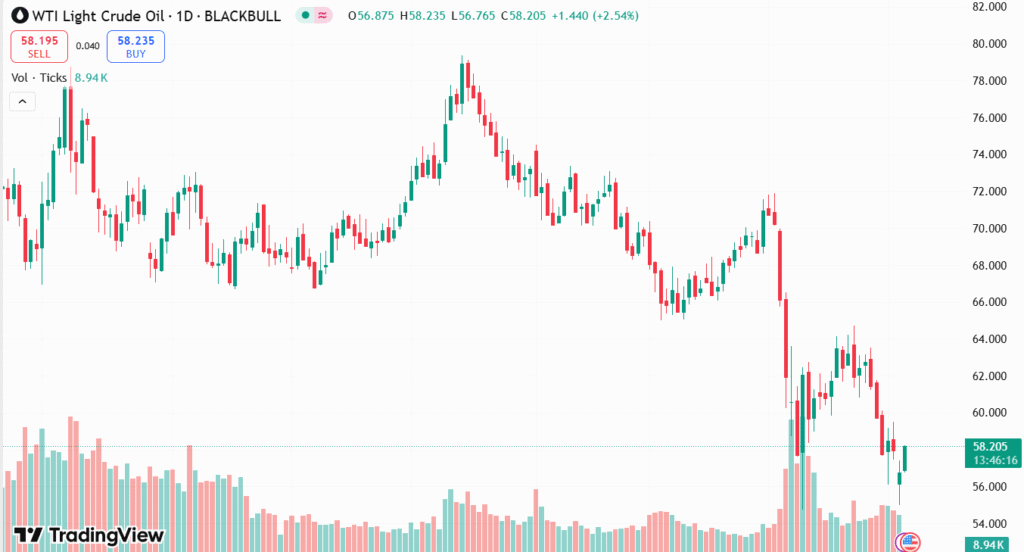West Texas Intermediate (WTI) crude oil prices rose above $57.50 per barrel in Asian trading on Tuesday, as recovery continued despite increasing concerns over surging global supply and soft demand. The rally comes after a near 2% fall on Monday but remains contained as OPEC+ ramps up output increases, committing an extra 411,000 barrels per day (bpd) for June. This is the second straight monthly rise and partly unwinds earlier production reductions. At the same time, recession concerns, weak refined fuel demand, and an accumulation of world crude stocks—increased by 150 million barrels since mid-February—are putting downward pressure on prices, leaving the market’s near-term trend uncertain.
KEY LOOKOUTS
• Look for additional reports on output hikes, particularly if the group chooses to entirely unwind voluntary cuts by October as compliance problems loom.
• Further rises in worldwide inventories, now higher by 150 million barrels since February, will tend to dampen price momentum.
• Low demand for import refineries of refined fuel, especially in Asia, is an essential pressure point and may foretell wider economic weakening.
• Economic data and fears of recession in major economies will be decisive in determining expectations of oil demand and price directions.

Oil market players need to watch OPEC+ production closely as the recent move by the group to increase 411,000 bpd in June could be followed up with a total roll back of voluntary cuts in October if issues around compliance continue. Increasing world crude inventories—up by 150 million barrels since mid-February—present a huge threat to price stability, particularly in an already struggling market with poor demand for refined products. Moreover, economic uncertainty and ongoing recession concerns continue to weigh on demand expectations, so macroeconomic fundamentals remain a key area to monitor in the coming weeks.
Investors need to look out for additional OPEC+ production adjustments and increasing global crude inventories, which could weigh on prices. Softened refined fuel demand and ongoing recession concerns also represent key downside threats to the oil market.
• WTI crude prices rebounded above $57.50 in Asian trade after falling by almost 2% on Monday.
• OPEC+ rolled back further cuts by 411,000 bpd in June, extending its phased reversal of earlier cuts.
• Total hike for April–June amounts to 960,000 bpd, reversing 44% of cuts since 2022.
• Saudi Arabia is urging faster rollback of cuts to sanction non-compliant members such as Iraq and Kazakhstan.
• Global crude inventories have increased by 150 million barrels since mid-February, putting pressure on prices.
• Demand for refined fuel continues to be weak, especially in key importing regions.
• Fears of recession continue to bear down on oil demand prospects, curbing bullish pressure in the market.
West Texas Intermediate (WTI) crude oil remains in the spotlight as it holds ground above the $57.50 level, even against a background of increasing anxiety over world oil supply. OPEC+ last week decided to boost production again in June, marking a change of heart as the alliance put an extra 411,000 barrels per day onto the market. This step is one part of a larger initiative to reverse prior output reductions and bring production levels back closer to pre-cut levels. Nations such as Saudi Arabia are taking the lead in facilitating this ramp-up, as they aim to impose discipline on non-compliant members who have not always fulfilled their output commitments.
WTI Crude Oil DAILY CHART PRICE

CHART SOURCE: TradingView
Meanwhile, the oil market is also confronted with ongoing challenges on the demand side. Global consumption continues to be pressured by poor demand for refined fuel and general economic uncertainty. Inventories have been rising steadily, suggesting that supply might be outstripping demand at the moment. With more oil on the market and less being used, the question is still how the market will reconcile these two forces. Looking forward, moves by OPEC+ and changes in global economic sentiment will be key to shaping the future trajectory of the oil market.
TECHNICAL ANALYSIS
WTI crude oil is stabilizing signs at the $57.50 level after rallying off recent lows. Price is trying to hold above this psychological level, but bulls are likely limited for now, with resistance likely in the $58.50 to $59.00 range. Short-term indicators point towards consolidation, as the Relative Strength Index (RSI) lingers in neutral ranges, indicating indecision in traders. A continuous move above crucial resistance points may pave the way for more gains, while a fall below $57.00 may indicate increased bearish pressure over the short term.

FORECAST
In case the market mood changes and buying interest starts to firm up, WTI crude may experience more upward momentum. A sustained economic upturn in global activity or indications of improved fuel consumption—specifically from key economies such as China and the U.S.—can foster upward prices. Furthermore, any indications of reduced supply, either from rising geopolitical tensions or increased compliance within OPEC+, can also offer upward pressure. Here, WTI can target resistance levels of approximately $59.00 to $61.00 in the short term.
On the negative side, oil prices are exposed to some bearish influences. Increasing global inventories, persisting softness in refined fuel demand, and recessionary concerns can bear down on market sentiment. If OPEC+ production rise accelerates ahead of demand recovery, or macroeconomic indicators deteriorate, WTI can find it difficult to sustain present levels. A fall below the $57.00 support level can facilitate more falls, which can take the price back to lower levels around $55.50 or even $54.00.







